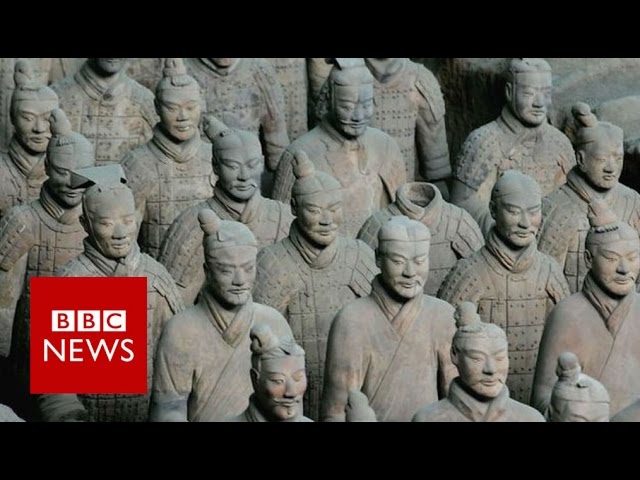The Terracotta Army Soldiers are a collection of terracotta sculptures depicting the armies of Qin Shi Huang, the first Emperor of China. It is a form of funerary art buried with the emperor in 210–209 BCE and whose purpose was to protect the emperor in his afterlife. The figures, dating from approximately the late third century BCE, were discovered in 1974 by some local farmers in Lintong District, Xi’an, Shaanxi province. The figures vary in height according to their roles, with the tallest being the generals. The figures include warriors, chariots, horses, officials, acrobats, strongmen, and musicians. Current estimates are that in the three pits containing the Terracotta Army there were over 8,000 soldiers, 130 chariots with 520 horses and 150 cavalry horses, the majority of which are still buried in the pits.
History of the Terracotta Army
The Terracotta Army was constructed in the late third century BCE to serve as a tomb guard for the first Emperor of China, Qin Shi Huang. The terracotta figures were placed in the emperor’s tomb complex, which was located near the ancient city of Xi’an. The army was discovered in 1974 by a group of farmers who were digging a well. The farmers had no idea what they had discovered, but soon the site was identified as the tomb of the first emperor. The Terracotta Army has since become one of the most significant archaeological finds of the 20th century.
The Purpose of the Terracotta Army
The purpose of the Terracotta Army was to serve as an afterlife guard for the first emperor. The figures were placed in the emperor’s tomb complex to protect him in his afterlife. The figures vary in height according to their roles, with the tallest being the generals. The figures include warriors, chariots, horses, officials, acrobats, strongmen, and musicians.
The Construction of the Terracotta Army
The Terracotta Army was constructed in the late third century BCE by a team of artisans and craftsmen. The figures were made from clay and then painted with vibrant colors. The figures were then placed in the emperor’s tomb complex. The figures were also placed in a variety of poses, such as marching, standing, and kneeling.
The Significance of the Terracotta Army
The discovery of the Terracotta Army in 1974 was a significant archaeological find of the 20th century. The figures provide insight into the practices and beliefs of the ancient Chinese. The figures are also a testament to the skill and artistry of the craftsmen who created them. The figures have since become a popular tourist attraction and have been featured in numerous films, television shows, and video games.
The Legacy of the Terracotta Army
The legacy of the Terracotta Army is one of artistry and craftsmanship. The figures provide a glimpse into the practices and beliefs of the ancient Chinese. They also demonstrate the skill of the craftsmen who created them. The figures have since become a popular tourist attraction and have been featured in numerous films, television shows, and video games.
Conclusion
The Terracotta Army Soldiers are a collection of terracotta sculptures depicting the armies of Qin Shi Huang, the first Emperor of China. It is a form of funerary art buried with the emperor in 210–209 BCE and whose purpose was to protect the emperor in his afterlife. The figures, dating from approximately the late third century BCE, were discovered in 1974 by some local farmers in Lintong District, Xi’an, Shaanxi province. The figures vary in height according to their roles, with the tallest being the generals. The figures include warriors, chariots, horses, officials, acrobats, strongmen, and musicians. The discovery of the Terracotta Army in 1974 was a significant archaeological find of the 20th century. The figures provide insight into the practices and beliefs of the ancient Chinese. The figures are also a testament to the skill and artistry of the craftsmen who created them. The figures have since become a popular tourist attraction and have been featured in numerous films, television shows, and video games.


0 Comments